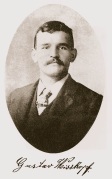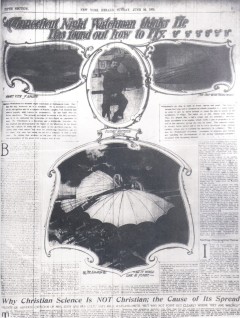New York Herald, June 16, 1901, Sec. 5, p.3
Transcript.
Illegible text: "xxx".
Direct quotes of statements by Whitehead in bold italics (see below):
Gustave Whitehead is a humble night watchman at Bridgeport, Conn. During the day, however, he is a scientist. He is devoted to problems of air navigation and is a compeer of Maxim, Langley, Von Zeppelin and others equally well known in aeronautics. He has built fifty-six flying machines. The present perfected invention is his fifty-seventh and in it, he embodies his principles of bird flight as applicable to man. Mr. Whitehead is a Bavarian and a worldwide traveller. He has studied and photographed the flight of the albatross in the South Seas, the vulture in India and the eagle in the northern regions. He claims that what nature has done for ornithology, machinery can do for man. His ship has sailed the air for a distance of half a mile clear. He claims that airships on his plan will yet circumnavigate the atmosphere of the globe with a single load of fuel.
Whitehead’s air ship is built of wood, canvass and steel. The body is sixteen feet long and is mounted on wheels propelled by a small engine in order to get up speed enough to cause the ship to mount on the aeroplanes, or wings. The latter are of silk, ribbed with bamboo. They are shaped like bat’s wings and are stationary. Between these aeroplanes is an engine, which works a pair of propellers at the will of the operator, giving the ship its speed. This separate engine is twenty horse power and is run by force developed from calcium carbide, whose gas is exploded by electricity in cylinders. This is also Mr. Whitehead’s invention. Aeronauts in America and Europe are watching the developments of the daring watchman-scientist’s invention with increasing interest.
BRIDGEPORT is the inventor’s Eden. Everywhere is the sound of brass, the clatter of shuttles and the whir of wheels, day and night, summer and winter. It is little wonder, then, that the sojourner in the Park City soon acquires casters in the cranium, breathing as he does a pregnant admixture of genius, iron filings and gunpowder.
Bridgeport has many foreign quarters, and to their darkest depths the bacillus of invention penetrates, with the effect that every now and then somebody is carried in a straitjacket to Middletown or
else startles the world with some amazing mechanical achievement. Out of the heart of the Bavarian quarter of Bridgeport comes the latest aspirant for wealth and honors. His name is Gustave
Whitehead, and his invention is an air ship constructed on the natural lines of the swift-winged bat.
Mr. Whitehead is a young man still in spite of the fact that he has built fifty-six air ships of various designs previous to this one, his latest one unifies all the good points of the former with some new points original to xxxx xxxxx xxxxx xxxnising. The most important of these is the employment of calcium carbide as motive power – something that comes [naturall]y being a genuine inspiration xxxxxxx ability of aerial navigation to carry great power without too great weight being hitherto the greatest obstacle to manned flight.
Mr. Whitehead has been making air ships since he was six years old. His first one was constructed at that early age out of his grandmother’s Sunday parasol. That was in far off Bavaria. After passing through the high school of Ausperg, the youthful inventor became discontented with his slow xxxxxxx and started about the globe on a maritime career. He saw a good deal of foreign countries and peoples, finally settling down in America as offering the best base for his aerial enterprises, making trips to England and Europe however, as occasion demanded to keep in touch with aeronautical progress achieved under Maxim Zeppelin, Lilienthal and the ill-fated Andrée and others who are pioneers in this dangerous and exciting sport which promises such xxxxxxx and practical results.
The artfulness of the inventor is patent in his skillful solution to the problem of air navigation. Xxx xxxx all these years, although required to earn his daily bread during darker hours of the day, while he xxxxxx xxxx xxxx xxxxx recreation the time necessary to proceed with his inventions. He is at xxxxx employed at night in one of Bridgeport’s industrial factories, working xxxx his xxxxxx xxx xxxxx by day. It speaks well for his prodigy in industry as well as xx xxxxxxx xxxxxx xxxx of great endurance that he is able to serve two masters with xxxxx credit to him.
“Power generated with the minimum of weight is the problem of aerial navigation”, said Mr. Whitehead. "Heretofore the common means of generating power have been employed either by means of electro-dynamic apparatus, steam, petroleum, naphtha, etc.. It is well proven, at least conclusively, to say that the air ship of the future will depend upon the generated power, and will remain always heavier than the air rather than something made lighter, as by hydrogen gas, for buoyancy.
“Balloons will necessarily be always at the mercy of wind and gravitation, whereas a winged machine which has its own power intact within it like the albatross or turkey may rise or fall at the will of the operator regulating the speed and power by xxxxxing Xxxxxx xx xxxxxxxxx which is its xxx xxxxer. This construction is based upon many years’ study of birds’ tail sets of the sea and high mountain varieties, from the gull of the Pacific to the condor of the Andes, but of the meaner species – the swift winged swallow or the night soaring bat.
“It is one thing to make an air ship which allows the operator to take a leap off a high cliff and soar three or four miles over the level plain. It is scarcely more than jumping from a sixth story window strapped to a strong umbrella. But to move along on the level ground for a short distance on a truck as my present flying machine does, pursuing an upward tendency as the speed progresses, finally leaving the ground altogether and moving along, propelled by its own internal machinery – this is the xxxx xxxxxxx.
“And this is exactly what I have achieved with my greatest invention. My longest flight has not been more than half a mile and that has been accomplished with speed and complete safety. To construct an air ship which will carry a passenger a quarter of a mile over level ground does not sound like a very wonderful achievement but xxve xxxxxxxxs it is. This little xxxx proves my theory correct. The balloon is bound to be discarded in experiments in air navigation for the air ship of the future will be heavier than the air and impelled by its own internal mechanism.”
“Now, what is the ideal mechanism for aerial flight? Naturally the maximum power combined with the minimum weight. If your airship weighs a hundred pounds, your engines, boilers and fuel must approach as nearly an equal weight as possible. In the airship which I have constructed a twenty horse power double compound engine furnishes all the power necessary for sustaining weight. The pressure developed from calcium carbide and the gas generated therefrom is exploded in the cylinders. In this engine, weighing not more than thirty-five pounds, I can develop as much power as is possible in a steam boiler weighing three hundred pounds, and fuel necessary for a long flight instead of weighing several hundred pounds like coal or petroleum, weighs less than fifteen pounds. This calcium carbide engine is my own invention as well, and promises great things for automobile and other machines which require great power with the least possible weight.
“There are two engines in my airship. One is on the floor of the body proper for running the ship along the tracks til it acquires the necessary speed rise up the fixed aeroplanes, which are spread like wings on either side. The upper engines are placed between the aeroplanes giving swift rotary motion to the propeller blades which are six feet in diameter with a blade surface of four square feet. These are sufficient to keep the entire body in motion while suspended upon the aeroplanes, the weight of the body of the ship being about fifty pounds, the total weight of aeroplanes, engines, propellers, fuel etc. being about one hundred and fifty pounds.
“The body proper is sixteen feet long, ribbed with light wood and steel, and covered with canvas tightly stretched over the framework. The wings are of silk, thirty-eight feet from tip to tip, with a ten foot rudder tail, all braced with bamboo and light steel, and capable of being folded up like the wings of a gigantic beast when at rest. A thin mast and bowsprit give additional firmness to the stationary aeroplanes and the tail, which can be moved up or down with a view to guiding the machine while on a horizontal course. The lateral steering is done by running one propeller faster than the other, while the body is suspended upon its 130 square feet of silk.
“Aerial navigation is no longer the Darius Green nightmare that popular illusion perpetuates. It has become a scientific possibility. From the balloon of Montgolfier, in 1783, down to the splendid achievements of modern investigators like Langley, Maxim, Holland, von Zeppelin, Lilienthal and others, The progress has been steady and promising, while the necessity of aerial inventions becomes more and more apparent in naval and military warfare, in postal service and all transportation problems. Photography has given us most complete theory of bird flight under many conditions.”




